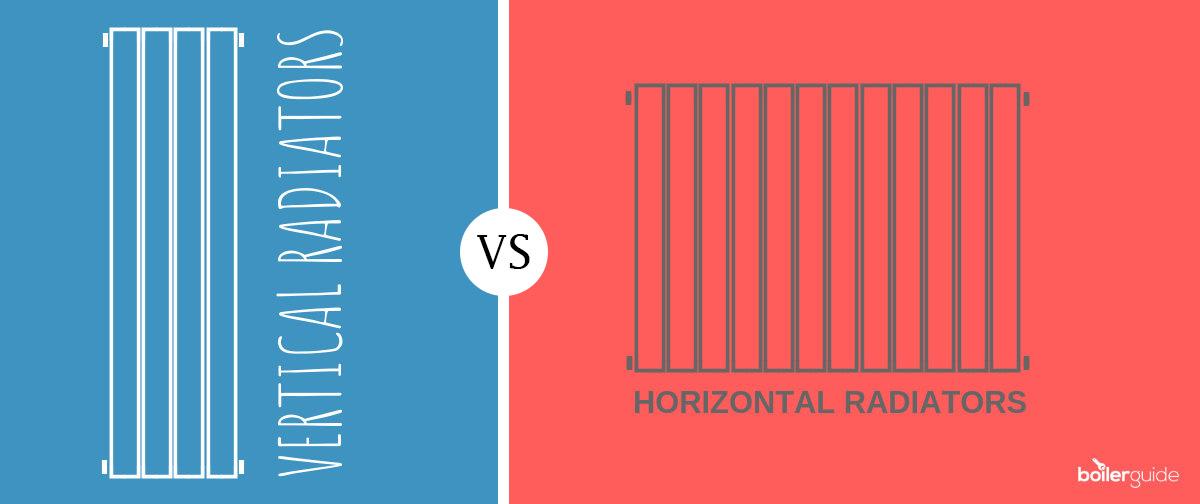Vertical vs Horizontal Radiators

If you were to picture a radiator in your head, you'd most likely see a conventional white horizontal radiator, a common feature of many UK homes. Nowadays, they're not the only option when it comes to installing new radiators and they don't even have to be horizontal.
While horizontal radiators are still effective house warmers, vertical radiators can be equally as good, so we're pitting them against each other to help you decide which is best for your home.
What are vertical radiators?
Vertical radiators are much more obvious than horizontal radiators, giving you the freedom to think more creatively with the style. As they travel up the wall from floor to ceiling, the heat is emitted right into the centre of the room.
They're also a more slender option to their horizontal counterparts, which will help with furniture placement.
What are horizontal radiators?
Horizontal radiators are the traditional option when it comes to choosing new radiators for your home. They often sit underneath windows to counteract the cooler temperatures and tend to take up little space along the wall.
If your home already has horizontal radiators then a like-for-like replacement is probably the easiest choice when it comes to installation.
Vertical radiator benefits
Fitting a vertical heated towel rail in the bathroom has become popular with homeowners looking for a more modern style but why limit that design to one room? Vertical radiators can be fitted in any room and bring a different heating experience to the home.
Ideal for small spaces
You can utilise more space in smaller homes with vertical radiators as they can be installed on walls that aren't wide enough for horizontal radiators and still effectively heat the home.
Towel rails
Installing a vertical radiator in a bathroom will not only heat the space but your towels too if you fit a radiator that has a towel rail.
Styles and colours
Vertical radiators aren't exactly conventional in UK homes which would help to make even the dullest of designs stand out in a room.
Potential to increase property value
When selling your home, the modern, sleek and environmentally friendly vertical radiators could well appeal to potential buyers and help you get a bit more for your home.
Horizontal radiator benefits
We're used to seeing horizontal radiators in homes and that's because they're a tried and tested way of effectively heating a room. Let's find out why you might be better off with horizontal radiators rather than making the change to vertical.
Traditional
Horizontal radiators have been an ever present part of UK homes for many years and could even be considered traditional. In the end it's down to personal taste but some homes will suit vertical radiators more than others.
Fit under windows
If cold outdoor air is going to find a way into your home then it will be through the windows, having a radiator underneath the window will help to warm this air as it enters the room. Horizontal radiators can sit underneath windows, the ideal location to warm the cold air.
Vertical vs Horizontal: Costs
There are many different styles of radiator, both vertical and horizontal, which means that there can be quite a range in the potential costs.
| Type of Radiator | Typical Cost |
|---|---|
| Vertical | £100 – £800 |
| Horizontal | £90 – £500 |
As you can see, the potential costs for both vertical and horizontal radiators are roughly the same but you could end up spending more on a vertical radiator depending on the style you go for.
Vertical radiator considerations
Tricky installation
If you decide to replace horizontal radiators with vertical ones then they'll require different fittings and pipework. A longer installation than a like-for-like replacement.
Not to everyone's taste
While vertical radiators in the form of towel rails might be an a widely accepted form of heating a room, less people seem to like the idea of seeing vertical radiators in other rooms around the home.
Horizontal radiator considerations
Furniture placement
Horizontal radiators sit at the same height as a lot of furniture around the home like sofas, cabinets and tables which can block the heat from spreading around the room. Vertical radiators don't really have the same problem as they're a lot taller and not as wide.
Vertical vs Horizontal radiators: The verdict
Depending on the size of the rooms in your home, some might be more suited to one or the other. If you have a large bay window in your lounge that doesn't have wall space either side, then a horizontal radiator will comfortably sit underneath it. Should you have a small room where the walls aren't too wide, then a vertical radiator can fill the height of the room and heat it up quickly and efficiently.
Should you find that some or all of the radiators around your home, vertical or horizontal, aren't heating up properly then you should bleed them. Bleeding radiators is an essential part of life in the home to keep your heating running efficiently and make sure that your energy bills don't start increasing.
You can bleed radiators yourself, without the need for a heating engineer but if you have any doubts whatsoever then contact a qualified engineer.



